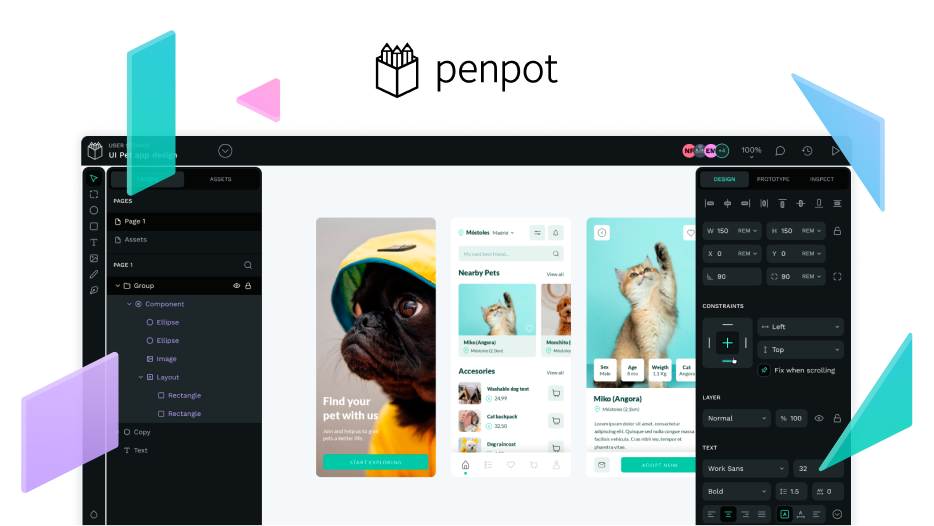For a team full of Blender super fans at Penpot, it was incredibly exciting news to have @dfelinto, their Product Manager, participate in our Open Chats.
Dalai is also part of the diverse talent that forms the Penpot community. In fact, during his Penpot Fest talk (The challenge of design in Open Source Projects), he pointed out how Blender integrates Penpot into their workflow to improve design collaboration and keep it in line with their open-source 3D software development.
To better understand Blender’s long history in the industry, lessons learned and ahá moments, we invited Dalai to our Penpot Open Chat.
Here’s how it went!
![]()
![]() Enjoy the whole interview on YouTube and Peertube, or tune in via Ivoox and Spotify.
Enjoy the whole interview on YouTube and Peertube, or tune in via Ivoox and Spotify.
Since the late 1990s, Blender has grown into one of the most popular open-source 3D suites, now serving over 3.5 million users globally. It’s used by a wide variety of creators, from independent artists to large film studios.
Given this growth, @diacritica asked Dalai about breakthrough moments for Blender in the past seven years.
Blender, not for everyone?
When you create something, it’s essential to define a target audience, which naturally means there will be a non-target audience as well. The same applies to software. “One of the first insights was realizing that after building something truly amazing for professionals we were going to offer it for free to everyone.” But Dalai understood that when designing a product, choosing a specific group also means accepting that some people will inevitably be frustrated.
Connexion to the whole process
Another “ahá” moment was realizing that as we grow, we need to stay connected to the entire process. “You can go for so long in a direction without feedback, without validation, and do something super solid but yet miss the mark and not be aware of it”, he explained.
Now that Blender has reached a certain size, it’s crucial to establish a process that ensures artists are truly connected to their work, continuously iterating and validating until the final result.
Feedback, key to preventing dysfunctional design contributions
What about the good, the bad, and the ugly sides of design contributions and workflows in Blender? @diacritica wanted to know.
Dalai kicked things off by stressing that no matter what, the goal is to ensure that the first design we roll out is solid: “It’s a bold statement”. He noted that while there’s a ton of processes in software development, we should focus on the essential concepts that run through every stage of the design pipeline.
The key? Listening to users. Gathering feedback is crucial—finding out what people are trying to achieve, what’s holding them back, and how we can make their lives easier. After all, Blender isn’t just a tool; for many, it’s a part of their lives and something that means a lot to them, even for Dalai who expressed during the Open Chat: “Bender was a gift to my life and I’m glad to keep giving it to people”.
Growing fast vs executing Penpot’s vision fast
It was now @diacritica’s turn to talk about Penpot. For Penpot, feedback is also essential to our process. Penpot actively gathers feedback from the community after implementing highly requested features, and we refine the tool based on that input. Additionally, at Penpot, we strongly believe in contributions, partnerships, and collaborations as an open-source company. @diacritca shared how “several features we’re building, like the Figma exporter plugin and native design tokens, are developed by other companies”.
That’s why we’re not in a hurry to grow the team. @diacritica explained that the project needs to be big but not necessarily the team.
I’ve seen open source since 1997, and creating a healthy ecosystem from the start pays off. What’s important is to build a healthy ecosystem right from the beginning and have a ratio between external contributors to internal.
"When we get a 4:1 ratio, meaning 4 times as many external regular contributors, we’ll be able to tell ourselves that there’s evidence that we have momentum, the community is there.”
Blender Plugins: the risk of breaking the generosity cycle
We were curious to find out about the plugins for Blender. According to Dalai, there is opportunity for improvement in the Blender market. While it features a Python-based plugin system, the Blender Market hasn’t been well-managed. Many believe buying plugins supports Blender’s mission, but it’s unclear how much revenue returns to the project.
“From day one that should have been made very clear. Also it is ambiguous the amount of levels of contributions plugins and amount they contribute is different but it’s not clear."
I didn’t imagine the plugin system would be that big in Blender. I like people making a living creating custom solutions but, only a bit on defense, when I see something that could ve been a core contribution to Blender and give more value.
For Dalai, “Blender is a gift to the world and you break the generosity cycle once you take it and wrap it”.
The conversation flew by for the two Blender fans, Penpot enthusiasts, and advocates of open-source design.
If you liked this interview, check out the Penpot Open Chat Youtube playlist, where we discuss design, code and open source and everything in between.

